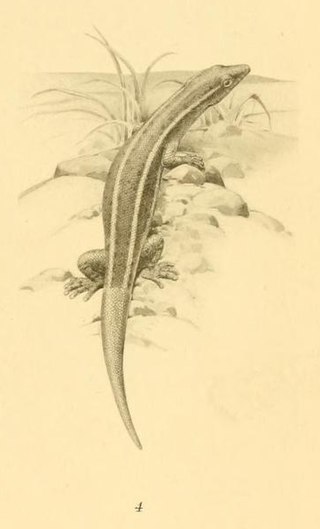
Gymnophthalmidae is a family of lizards with at least 250 species, sometimes known commonly as spectacled lizards or microteiids. They are called "spectacled" because of their transparent lower eyelids, which allow them to still see with closed eyes. As in most lizards, except geckos, these eyelids are movable. The Alopoglossidae have been recently moved from this family.
El Cerro del Aripo, at 940 metres (3,084 ft), is the highest point in the Republic of Trinidad and Tobago. It is part of the Aripo Massif and is located in the Northern Range on the island of Trinidad, northeast of the town of Arima.

Trinidad and Tobago are continental islands with a geologically very recent history of direct land bridge connection to South America. As a result, unlike most of the Caribbean Islands, Trinidad and Tobago supports a primarily South American flora and fauna and has greater diversity of plant and animal species than the Antilles. However, rates of endemism are lower than in the rest of the Caribbean because there has been less time for genetic isolation from mainland populations because of the history of land bridge connections and hence fewer opportunities for speciation, and so a greater proportion of the species in Trinidad and Tobago are also found on the South American mainland. Trinidad is nearer to mainland South America and has been directly connected to the mainland via land bridges more often and for longer periods than Tobago. This, as well as Trinidad's larger size and more varied topography and hydrology compared to that of Tobago allow greater species and ecosystem diversity on the former compared to that on the later of the islands.

Chironius scurrulus, commonly known as the smooth machete savane, is a large slender colubrid snake. It is also known as Wagler's sipo.
Pristimantis shrevei is a species of frog in the family Strabomantidae. It is endemic to Saint Vincent, the West Indies. Its common name is Saint Vincent frog.
Benjamin Shreve (1908–1985) was an American amateur herpetologist. He was from a wealthy Boston family of jewellers and worked at the Harvard Museum of Comparative Zoology as a volunteer. He was trained by Arthur Loveridge to deal with materials from elsewhere than Africa. Shreve described many species from the West Indies together with Thomas Barbour. In these papers, Shreve is said to have done the "spadework" while Barbour wrote "florid" introductions.
Oreosaurus is a genus of lizards in the family Gymnophthalmidae. The genus is found in South America.

Darlington's least gecko is a species of lizard in the family Sphaerodactylidae. The species is endemic to the Dominican Republic.

The Tobago least gecko is a species of lizard in the family Sphaerodactylidae. The species is endemic to the Caribbean and northern South America.

Sphaerodactylus savagei, also known commonly as the Altagracia speckled sphaero or Savage's least gecko, is a small species of lizard in the family Sphaerodactylidae. The species is endemic to the Dominican Republic.
Shreve's least gecko, also known commonly as the northwest Haiti blotched sphaero and the northwest Haitian blotched geckolet, is an endangered species of lizard in the family Sphaerodactylidae. The species is endemic to Haiti.
Andinosaura oculata, the tropical lightbulb lizard, is a species of lizard in the family Gymnophthalmidae. It is endemic to Ecuador.
Andinosaura petrorum is a species of lizard in the family Gymnophthalmidae. The species is endemic to Ecuador.
Andinosaura vieta is a species of lizard in the family Gymnophthalmidae. It is endemic to Ecuador.
Oreosaurus achlyens is a species of lizard in the family Gymnophthalmidae. It is endemic to Venezuela.
Oreosaurus mcdiarmidi is a species of lizard in the family Gymnophthalmidae. It is endemic to Chimantá Massif in Venezuela. It is named for Roy W. McDiarmid, American herpetologist, "for his contribution to the knowledge of the Pantepui herpetofauna".
Oreosaurus rhodogaster is a species of lizard in the family Gymnophthalmidae. It is endemic to Venezuela.
Proctoporus guentheri, also known commonly as Günther's lightbulb lizard , is a species of lizard in the family Gymnophthalmidae. The species occurs in South America.
Riama colomaromani is a species of lizard in the family Gymnophthalmidae. The species is endemic to Ecuador.
Anolis shrevei, the Cordillera central stout anole or Shreve's anole, is a species of lizard in the family Dactyloidae. The species is found in the Dominican Republic.






